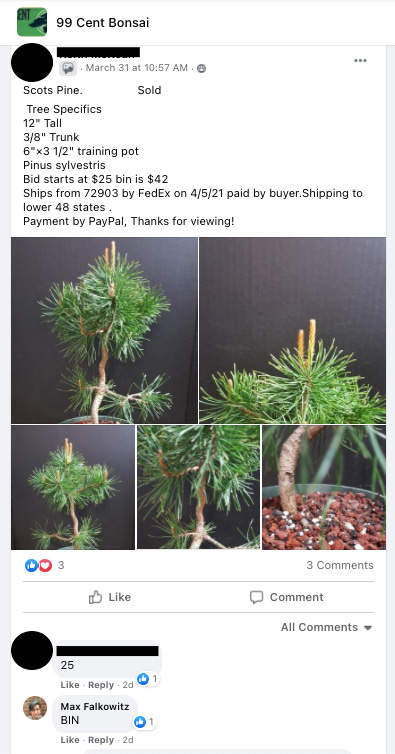The bonsai auction game
If you're looking for a well developed tree, these Facebook groups are the thing.
The question of “where do I buy trees for bonsai” is harder to answer than you’d think. Most of the “bonsai trees” online and in retailers are mass produced and lacking in character, more of a fast-fashion trinket than a tree to develop a years-long relationship with. I’ve written before about bonsai-hunting at garden centers; today we’re talking about online auctions.
Ebay has been useful to me of course. I search for “tree” once a day and have caught some nice deals, such as a Japanese maple that’s growing like a weed. Then a forum thread tipped me off to Facebook. Say what you will about Zuckerberg’s rogue state, it’s a fantastic place to find huge communities centered on whatever weird, hyper-specific thing you’re into, which I enjoy documenting now and again.
There are two big Facebook auction pages: Bonsai Auctions and 99 Cent Bonsai. Both are private groups, and I’d ask you not to join unless you’re seriously shopping for trees; I don’t want the bonsai people to get mad at me. Like all the best communities of freaks, both pages have a strict etiquette and coded language. It is against the rules to comment on a post without a monetary bid. There are extensive protocols about the binding nature of bids and listings. It’s expected for sellers to take certain kinds of photos and note specific features.
I fucking love it.
The screenshot above is my winning bid of an inexpensive pine I wanted to practice on. I caught the post 10 minutes after it was created, as I was hopping off the subway. The tree looked healthy, the soil appropriate, and the trunk had some natural movement that seemed promising. I knew someone would nab it soon, so I pounced.
A week later, here it was. I recently wrapped it in wire to emphasize the trunk’s contortions and to expose the lower branches, and am now trimming the phallic bud growths emerging from the pine’s unkempt bushes. The bare tree behind it is another 99 Cent Bonsai purchase, a European beech styled by someone in California. I’m using it to study branch refinement.
The thrill of the chase is a big part of the fun. So is spectating on bidding wars; you learn a lot about the aesthetic features of something by what people are willing to spend money on. But I also think there’s a sense of camaraderie that emerges from all these bonsai nerds gathering in one place. You see it in the reactions to when someone drops $1,800 on the “buy it now” price of a gnarly olive. Some posts are so irresistible that the decorum about commenting without a bid is momentarily dropped, so people can rave about a particular tree.
There’s a trident maple in this week’s auction that I have my eye on. The seller included a 360° video where he guides you through the tree’s features in a warm and heavy Southern accent. As he’s talking about the unique fused trunk at the top of the canopy, he’s interrupted by the sound of his child slamming the screen door open to show their dad something they did. It’s a moment.
Tree reading
I love this interview with Dr. Suzanne Simard, the ecologist who found that different species of trees collaborate and share resources underground through mycelial networks. [New York]
There’s new evidence that humans from 80,000 years ago may have set forest fires to alter their environment and develop new food sources. [Scientific American]


